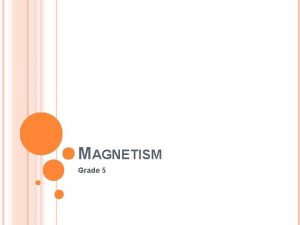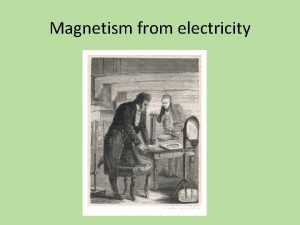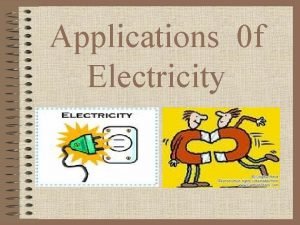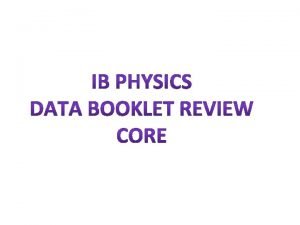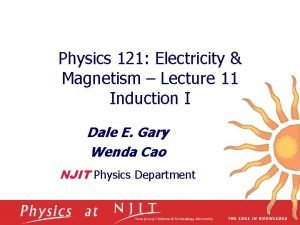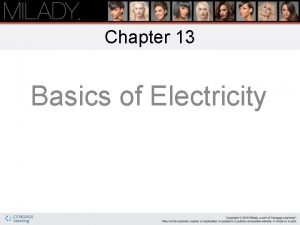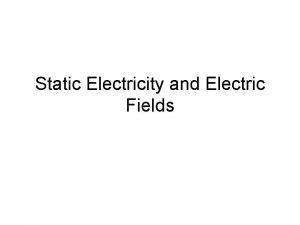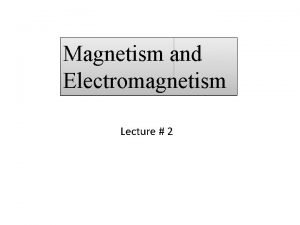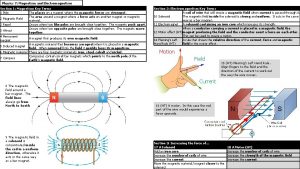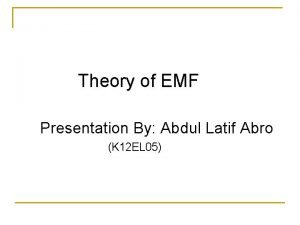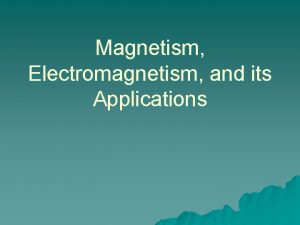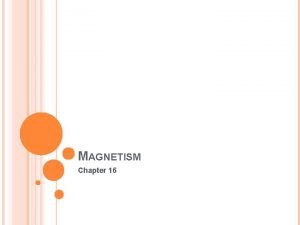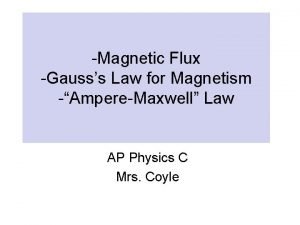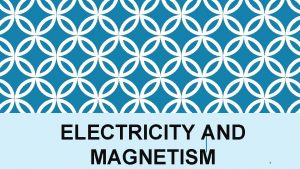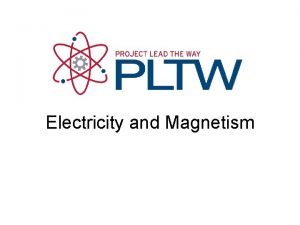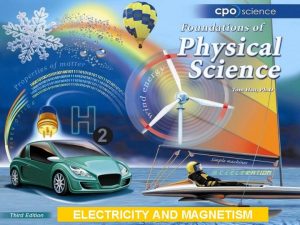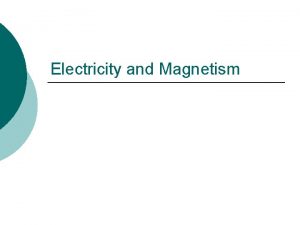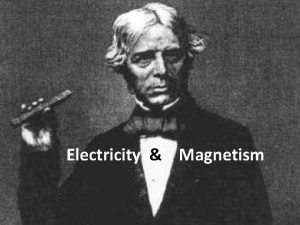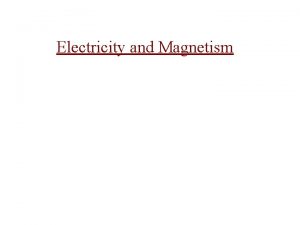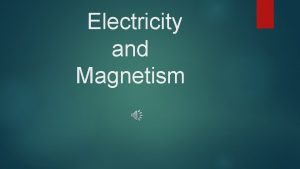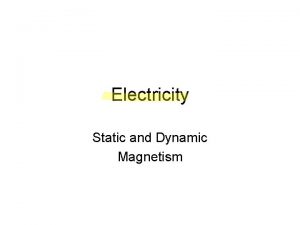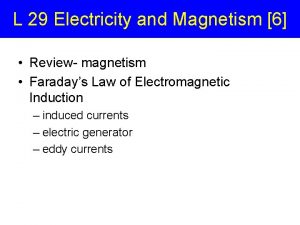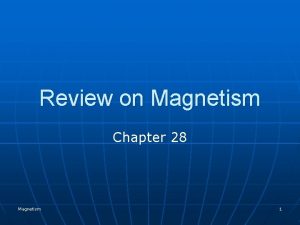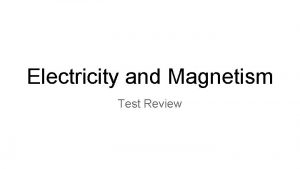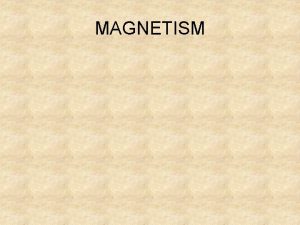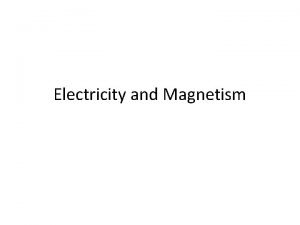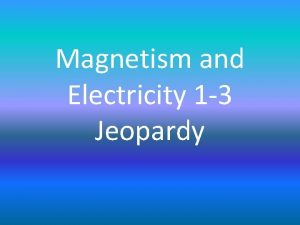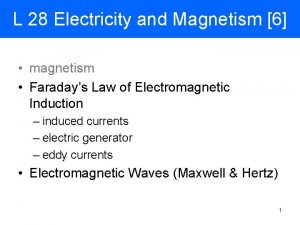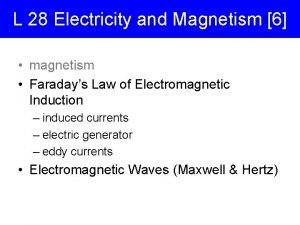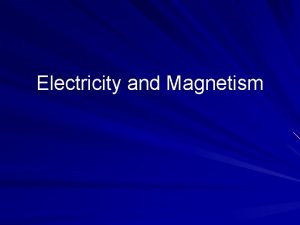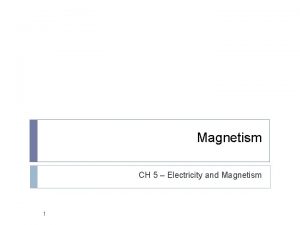L 29 Electricity and Magnetism 6 Review magnetism
![L 29 Electricity and Magnetism [6] • Review- magnetism- what is a magnet? • L 29 Electricity and Magnetism [6] • Review- magnetism- what is a magnet? •](https://slidetodoc.com/presentation_image_h2/8276ee9fc06b4592aa0d90bfa1df578a/image-1.jpg)




























- Slides: 29
![L 29 Electricity and Magnetism 6 Review magnetism what is a magnet L 29 Electricity and Magnetism [6] • Review- magnetism- what is a magnet? •](https://slidetodoc.com/presentation_image_h2/8276ee9fc06b4592aa0d90bfa1df578a/image-1.jpg)
L 29 Electricity and Magnetism [6] • Review- magnetism- what is a magnet? • Faraday’s Law of Electromagnetic Induction – induced currents – electric generator – eddy currents • Electromagnetic Waves (Maxwell & Hertz)

Laws of Magnetism • If you pass current through a loop of wire. you get a magnet Oersted’s discovery • Basic laws of magnetism electric currents produce magnetic fields (Ampere) magnetic field lines are always closed loops – no isolated magnetic poles • permanent magnets: the currents are atomic currents – due to electrons spinning in atomsthese currents are always there • electromagnets: the currents flow through wires and require a power source, e. g. a battery

Bar Magnet magnetic field lines Electromagnet straight wire with current

The electric motor When a current is present in a coil, it experiences a torque and rotates.

Faraday’s Law of Electromagnetic induction • Faraday thought that if currents could produce magnetic fields, (Oersted) magnetic fields should be able to produce currents • He was correct with one important requirement the magnetic field must be changing in some way to produce a current • the phenomenon that a changing magnetic field can produce a current is called electromagnetic induction Michael Faraday (1791 -1867)

Induced currents (a) A B magnetic field lines battery switch current indicator When a current is turned on or off in coil A, a current briefly appears in coil B The current in coil B is called an induced current. The current in B is only present when the current in A is changing.

Induced currents (b) a) No current is induced if the magnet is stationary. b) When the magnet is pushed toward the coil or pulled away from it an induced current appears in the coil. c) The induced current only appears when the magnet is being moved

Induced currents (c) • If an AC (time varying) current is used in the primary circuit, a current is induced in the secondary windings. • If the current in the primary windings were DC, there would be NO induced current in the secondary circuit.

electric generators When a coil is rotated in a magnetic field, an induced current appears in it. This is how electricity is generated. Some external source of energy is needed to rotate the turbine which turns the coil.

The transformer The voltage on the secondary depends on the number of turns on the primary and secondary. Step-up the secondary has more turns than the primary Step-down the secondary has less turns than the primary

Eddy currents • When time varying magnetic fields are around, currents can appear in nearby conductors --- these are eddy currents • an induction stove uses eddy currents to cook food Only the metal pot gets hot, not the glass pot or the stove.

Floating magnet – induced currents bar magnet slotted copper pipe As the magnet falls, it induces currents in the copper pipe known as eddy currents. These currents produce a magnetic field that opposes that of the falling magnet, so the magnet does not accelerate but descends slowly

The laws of electricity and magnetism • Law of electricity. — electric charges produce electric “fields” • Laws of magnetism. — – currents produce magnetic fields – magnetic field lines are closed loops – Faraday’s law of electromagnetic induction. — a changing magnetic field can produce a current (induced currents)

ELECTROMAGNETIC WAVES • Faraday laid the groundwork with his discovery of electromagnetic induction • Maxwell added the last piece of the puzzle James Clerk Maxwell (1831 -1879) Heinrich Hertz made the experimental discovery in 1886

Electromagnetic (EM) waves • A wave is a disturbance that propagates in a medium • transverse waves on a string • longitudinal sound waves in air • an electromagnetic wave is an electric and magnetic disturbance that propagates through space (even vacuum) at the speed of light 299, 792, 458 m/s or 186, 000 miles/s. No medium is required! • EM waves include radio, microwaves, xrays, light waves, gamma rays. . .

Electric and Magnetic Fields • electric charges produce electric fields (Coulomb’s Law) • electric currents (moving charges) produce magnetic fields (Ampere’s Law) • an electromagnetic wave is a combination of electric and magnetic fields that vibrate together in space and time in a synchronous fashion

Electric Field electric field of a positive charge Magnetic Field magnetic field of a current in a wire

the generation of an electromagnetic wave electric field wave emitter e. g. antenna magnetic field The time varying electric field generated the time varying magnetic field which generates the time varying electric field and so on. .

EM waves: transverse • the electromagnetic wave is a transverse wave, the electric and magnetic fields oscillate in the direction perpendicular to the direction of propagation E field direction of propagation B field

Electromagnetic waves • the EM wave propagates because the electric field recreates the magnetic field and the magnetic field recreates the electric field • an oscillating voltage applied to the antenna makes the charges in the antenna vibrate up and down sending out a synchronized pattern of electric and magnetic fields • an electromagnetic wave must have both an electric and magnetic field component

How radio waves are produced transmission line High Frequency Oscillator Dipole Antenna

Electromagnetic Waves Antenna: emits waves EM WAVE: electric and magnetic fields moving through space at the speed of light 186, 000 miles/sec

Radio antenna the oscillating electric field of the EM wave causes the electrons in the receiving antenna to oscillate at the same frequency the amplifier converts the electrical signal to sound waves

Common frequency bands 1 Hertz (Hz) = 1 vibration per second 1 KHZ (kilohertz) = 1000 Hz 1 MHZ (megahertz) = 1, 000 Hz • • • AM radio - 535 KHZ to 1. 7 MHZ FM radio: 88: 108 MHZ GPS: 1, 227 and 1, 575 MHZ Citizens band (CB) radio - 26. 96 to 27. 41 MHZ Cell phones: 824 to 1900 MHZ

Detecting (receiving) the Wave

The golden rule applies to electromagnetic waves • the golden rule: c = f speed = wavelength frequency applies to electromagnetic waves. • the speed c is roughly 300, 000 m/s • for example, the wavelength of a 1 MHZ radio wave is: wavelength = speed/frequency = 300, 000/1, 000 = 300 meters

Amplitude Modulation (AM) AM the information is coded into the way that the amplitude is modulated Frequency modulation (FM) FM information is coded into the way that the modulation frequency is varied

Electromagnetic spectrum = c

Microwaves • are in the frequency range of a few billion Hz or wavelengths of about several cm (about the same range as radar the “Radarange” • How do microwaves heat water? • Remember that the water molecule has a positive end a negative end. • The electric field of the microwave grabs onto these charges and shakes them violently a few billion times each second • all this shaking energizes the molecules making the water hotter and hotter.
 4 forces of nature
4 forces of nature Ib physics topic 5 questions
Ib physics topic 5 questions Electricity and magnetism lecture notes
Electricity and magnetism lecture notes Magnetism jeopardy
Magnetism jeopardy Sph3u electricity and magnetism
Sph3u electricity and magnetism Relationship between electricity and magnetism
Relationship between electricity and magnetism Magnetism and electricity
Magnetism and electricity Electricity and magnetism grade 5
Electricity and magnetism grade 5 Electricity and magnetism
Electricity and magnetism Electricity and magnetism
Electricity and magnetism Ampere
Ampere Electricity and magnetism
Electricity and magnetism Electricity and magnetism
Electricity and magnetism Electricity and magnetism vocabulary
Electricity and magnetism vocabulary Static electricity and current electricity
Static electricity and current electricity Current electricity
Current electricity Renaldo and nasreen build an electromagnet
Renaldo and nasreen build an electromagnet Chapter 13 basics of electricity
Chapter 13 basics of electricity Static electricity review
Static electricity review Artificial magnet example
Artificial magnet example Magnetism and electromagnetism
Magnetism and electromagnetism Magnetic field lines of a bar magnet
Magnetic field lines of a bar magnet Para and ferro magnetism
Para and ferro magnetism Magnetism and electromagnetism
Magnetism and electromagnetism What are properties of magnet
What are properties of magnet Gauss law of magnetism
Gauss law of magnetism Chapter review motion part a vocabulary review answer key
Chapter review motion part a vocabulary review answer key Ap gov review final exam review
Ap gov review final exam review Narrative review vs systematic review
Narrative review vs systematic review Example of inclusion and exclusion criteria
Example of inclusion and exclusion criteria







